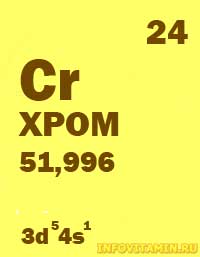Chromium — properties and application, daily allowance, contraindications, food sources of chromium
It has been proven that this metal plays an important role in the assimilation of sugars and fat metabolism. However, the use of chromium as a means for weight loss and muscle building is still purely hypothetical.
Chrome — what is it?
 Chrome. |
Chromium is a trace element that is used in various forms. In dietary supplements, it is usually its chloride or picolinate (salt absorbed by the intestine is better). The complex present in yeast, known as glucose tolerance factor and including chromium, is well absorbed, nicotinic acid (vitamin B3)and three amino acids — glutamic, glycine and cysteine.
Useful properties of chromium and its role in the body
Chromium is necessary for insulin to work. This hormone is responsible for the transfer of glucose from the blood to the cells, where it is «burned» with the release of energy. Insulin is effective and helps maintain normal blood sugar levels only if the body has enough chromium. This metal increases the number of insulin receptors on the cell membrane. By increasing our glucose tolerance (the ability to tolerate its consumption without negative health consequences) by increasing the effectiveness of insulin, chromium inhibits its production, and as a result suppresses the conversion of sugar into fats. This leads to a decrease in blood levels of cholesterol (especially «bad», i. e. low-density lipoproteins) and triglycerides.
Prevention
Chromium supplements reduce the risk of diabetes in insulin-resistant people. They produce enough insulin, but the sensitivity of the cells to it is lowered. As a result, in order to maintain normal blood glucose levels, the pancreas has to secrete increased amounts of this enzyme. However, even they may not be enough, and then type II diabetes (insulin-independent) develops with an excess of sugar in the blood, which is usually accompanied by obesity and hypercholesterolemia (high cholesterol) with all the consequences that follow from this. This risk is reduced by the prophylactic intake of chromium, which weakens insulin resistance, and therefore increases glucose tolerance.
The use of chromium
Stress, infection, increased physical activity accelerate the «burning» of glucose, and as a result, the mobilization of chromium, which is more intensively excreted in the urine. The same is observed with hyperglycemic exacerbations in diabetic patients. The intake of chromium with food usually barely reaches the norm, so in such situations it is advisable to take its supplements.
| Do you know? |
| Increased consumption of refined (white) flour and sugar increases the loss of chromium, threatening a deficiency of this element in the body. |
Our needs are the recommended daily allowance of chromium
There are no recommendations on the daily norm of chromium, but it is believed that its deficiency in adults can be prevented by doses from 50 to 200 mcg per day. It should be noted that even with a varied, healthy diet, it is almost impossible to get 200 mcg of chromium per day with food. The standard menu usually gives us 40-50 mcg/day, and a starvation diet (for example, when losing weight) is naturally less.
is a disadvantage. Chromium deficiency is fraught with irritability, by loss of strength, weight gain and impaired limb sensitivity, as well as exacerbation of insulin-independent diabetes.
+ Excess. Chrome additives are apparently harmless. However, their high doses make it difficult to assimilate iron and zinc.
| For your information |
| Allergy is caused by hexavalent chromium, which is different from biologically active trivalent chromium. Traces of it are present in washing powders and jewelry. In hypersensitive people, it can cause a skin reaction — contact dermatitis. In non-ferrous metallurgy, working with it is fraught with occupational diseases of the skin, digestive organs, lungs and kidneys. Chromium is important for the synthesis and preservation of nucleic acids (DNA and RNA) — molecules that store and implement the genetic information of the body. Chromium supplements by themselves do not lead to either weight loss or muscle building. For this, a balanced diet and regular physical activity are more important. |
Indications for the use of chromium
• Difficult assimilation of proteins, fats or carbohydrates.
• Elevated blood glucose levels (insulin resistance, type II diabetes).
• Elevated blood levels of «bad» cholesterol (low-density lipoproteins) and triglycerides.
Contraindications
Diabetic patients should take chromium only after consulting with a doctor. They may have to adjust the doses of insulin and/or other medications already prescribed for their illness.
| Caution! |
| • If you are being treated with medications, take any medications only with the permission of a doctor. |
Methods of using chromium preparations
• Doses
 Chromium is often included in polymineral tablets. |
Usually chromium in additives is combined with other minerals, so it is necessary to specify its amount in the preparation according to the label on the package. In one tablet or capsule it should be from 25 to 200 mcg (more is dangerous). Such dietary supplements are taken as general tonic, as well as when losing weight with the help of a starvation diet and to increase the effectiveness of insulin.
• Reception scheme
Chromium should be taken with meals, washed down with plenty of water to mitigate its irritating effect on the stomach. It is advisable to combine this drug with products rich in vitamin C, and avoid parallel consumption of calcium carbonate and antacids, which complicate the absorption of salts chrome.
Release form
• Pills.
• Capsules.
• Drinking solution.
Food sources of chromium
Whole grains, potatoes, honey, yolk, mushrooms, seafood and, of course, yeast are rich in chromium — the champion in the content of this trace element.
To the section «Mineral substances — descriptions, properties and applications»
•••••••••
